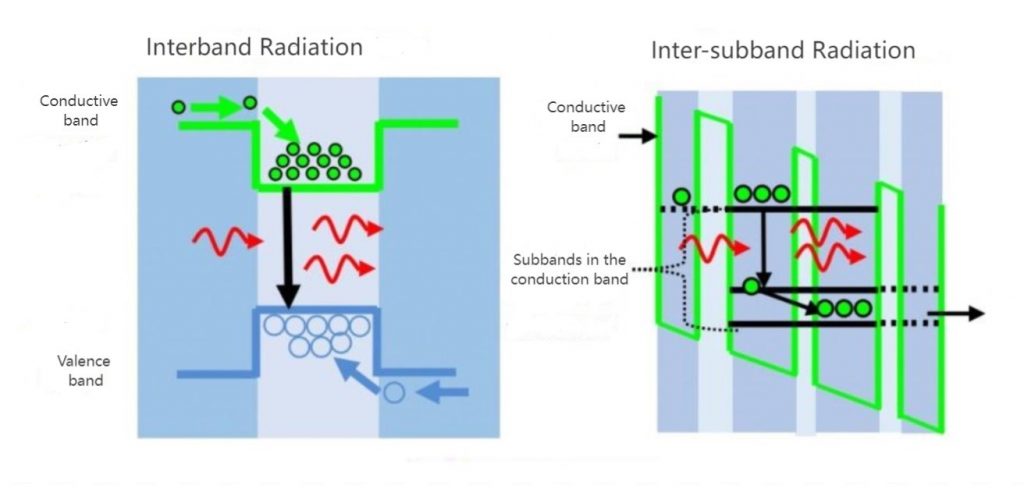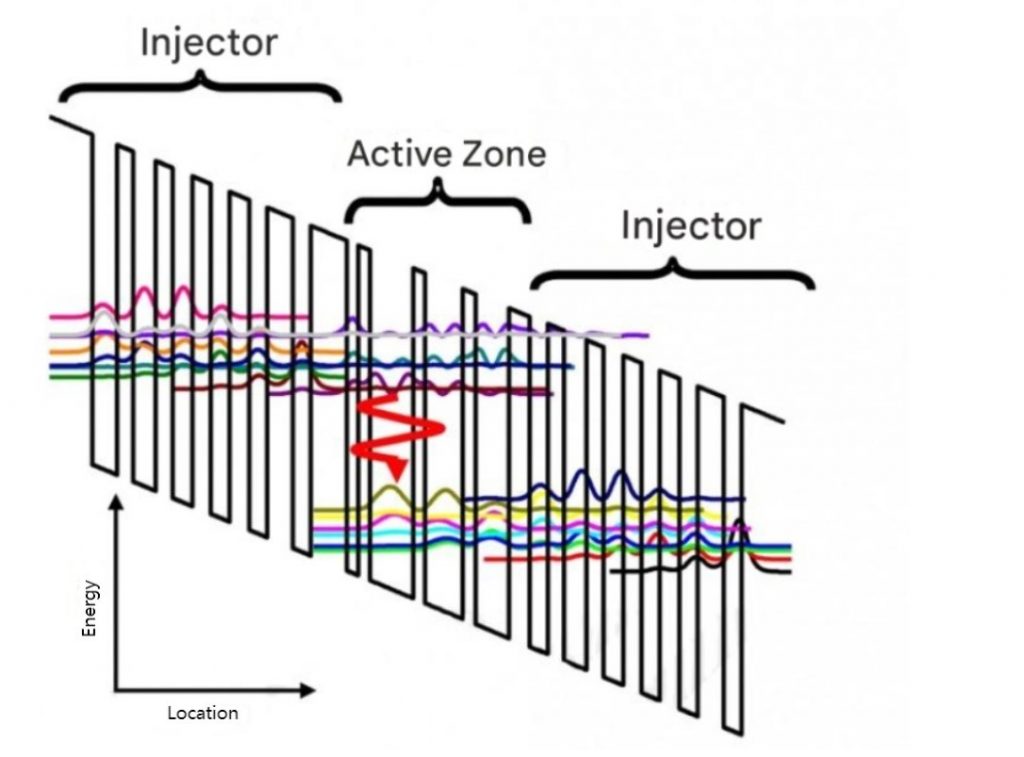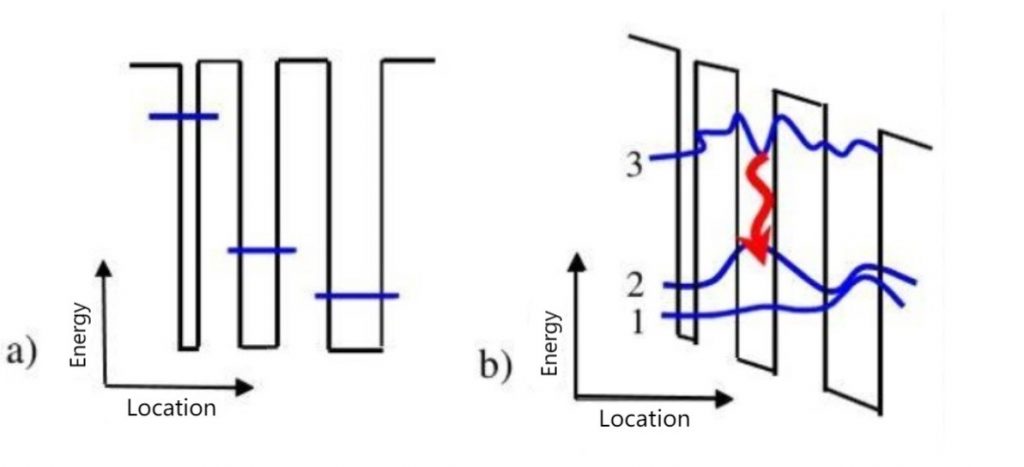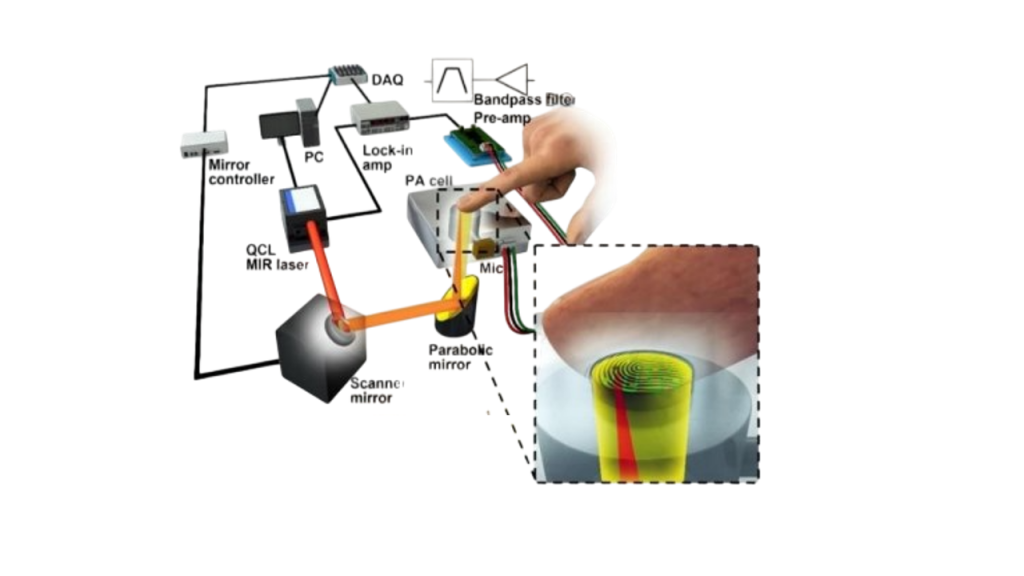Quantum Cascade Lasers-QCL
Due to their small size, high reliability, and ease of use, traditional semiconductor diode lasers play a dominant role in fields such as telecommunications and consumer electronics (e.g., optical fiber communication and compact disc (CD) players). In these lasers, light is generated by the recombination of electrons and holes across the energy band gap located between the crystal’s conduction band and valence band. The energy difference between the two bands determines the laser wavelength. This difference is called the “bandgap” and generally depends on the material used.
In contrast, a Quantum Cascade Laser (QCL) is a semiconductor laser containing only one type of carrier (electrons) and is based on two fundamental phenomena of quantum mechanics: tunneling and quantum confinement. Although the basic concept was proposed as early as 1971, more than two decades passed before a real-world device was demonstrated in 1994.
The Operating Principle of Quantum Cascade Lasers
While photon emission in classical semiconductor lasers relies on electron-hole coupling across the band gap, QCLs rely on a completely different approach. Photon emission in QCLs is achieved by exploiting the phenomenon known as “sub band transitions,” which occurs when electrons scatter between bound states created by quantum confinement in ultrathin layers of semiconductor materials. Figure 1 schematically illustrates the operating principles of classical semiconductor lasers that utilize inter-band transitions and QCLs that utilize inter-band transitions. When examining the operating principle of QCLs, the radiation wavelength is not limited by the intrinsic band gap of the relevant semiconductor compound but can be easily modified by varying the layer thickness. Layer thicknesses are typically around a few nm, and these thicknesses allow electronic states to interact with each other, creating the necessary sub-energy levels through these interactions, and allowing electrons to tunnel from quantum wells to barriers.

Figure 1. (Left) Schematic representations of interband emission and (Right) subband emission.
Quantum Cascade Laser Structure
The QCL design generally consists of two distinct regions, called the injector region and the active region (Figure 2). The active region is the region where light is generated in a quantum cascade laser.

Figure 2. Schematic representation of the active region sandwiched between two injector regions of the QCL structure.
The active region of a typical QCL structure with three quantum wells, with voltage applied, is shown schematically in Figure 3, along with its energy levels, in the unapplied (a) and applied (b) states. The energy levels observed in the quantum wells arise due to the quantum confinement effect created by the varying thickness of the quantum wells and barriers. In the active region design shown in Figure 3, when electrons transition from high energy state 3 to low energy state 2, a photon associated with the energy difference is generated. Then, the electrons transition from energy level 2 to ground state 1 via the relaxation mechanism via phonons. This transition occurs more rapidly when the difference between energy levels 1 and 2 is comparable to the optical phonon energies (~35-40 meV). The longitudinal optical phonon energy values for In0.53Ga0.47As are 34 meV, for GaAs 35 meV, and for InP 43 meV. In these structures, the desired transition can be maximized by calculating the overlapping states of the wave functions of the dipole matrix element or energy levels to emit radiation only at the desired wavelength.

Figure 3. Illustration of the quantum cascade laser structure with three quantum well active regions with (a) and without (b) applied potential difference.
The injector region, shown in Figure 2, connects the active regions to facilitate the electron cascade process. The generation of numerous photons for a single injected electron during the cascade process ensures that quantum cascade lasers achieve external quantum efficiencies greater than 100%. The injector region also serves as an electron reservoir for the 3rd energy level (the highest energy level in other designs) of the active region and serves to remove electrons from the 2nd and 1st energy levels. The injector region contains mini bands of energy levels to transport electrons to the ground state for rapid reuse via phonons. In addition to the mini-bands, the injector region also creates mini-cavities, which are devoid of any energy states. These regions prevent electrons from escaping to the continuous levels or the next injector region without photon emission.
Application Areas of Quantum Cascade Lasers
Absorption Spectroscopy
All covalently bonded materials have a unique absorption spectrum in the infrared (IR) spectrum due to the permitted vibrational and rotational modes arising from their molecular structure. Since no two materials have the same molecular structure, the distinct absorption bands corresponding to each bond create a unique spectrum called fingerprint region.
Traditionally, infrared absorption measurements have been performed using Fourier transform infrared (FT-IR) spectrometers. These instruments consist of a broadband infrared light source (known as a globar) and a scanning interferometer. The system is internally calibrated with a stabilized helium-neon laser. QCLs significantly simplify the system by eliminating the interferometer entirely and replacing the infrared light source with a tunable QCL. Consequently, QCLs are widely used in chemical analysis and chemical imaging because they significantly reduce system cost and complexity. In addition, absorption spectroscopy can also be performed in the terahertz (THz) region, and QCLs are widely used in this region.

Figure 4. Visual of the QCL application area
Trace-Gas Detection
Although technically a sub-branch of absorption spectroscopy, trace-gas detection has evolved into an independent classification over time. This is due not only to the use of infrared absorption in gas analysis, but also to the fact that atmospheric transition bands align with the mid-infrared region (as shown in Figure 4). Figure 4 also highlights the tunable wavelength ranges for some commercially available Distributed Feedback Quantum Cascade Lasers (DFB-QCLs).
While various measurement methods exist for trace gas detection in the infrared region, the most widely used technique today is Tunable Diode Laser Absorption Spectroscopy (TDLAS). In TDLAS, a laser rapidly scans a specific absorption line in the infrared absorption spectrum of the analyzed gas, mapping its cross-sectional density and spectral shape. When a single-frequency laser source is scanned across the absorption band, the entire line shape of the vibrational band can be characterized, allowing the precise molecular concentration of the gas to be determined. Although the term TDLAS includes the word “diode,” QCLs are more commonly preferred in these applications due to the required wavelengths and tunability. Furthermore, although many gases also have electronic absorption bands in the ultraviolet (UV) and visible regions, Rayleigh scattering prevents these wavelengths from being used effectively for remote sensing applications.

Figure 5. Atmospheric transmission spectra and tunable wavelength ranges of various DFB-QCLs in critical gas absorption bands.
Infrared Countermeasures
Since the early days of heat-seeking missile technology, efforts have been made to develop countermeasures to deceive infrared guidance sensors. Initially limited to flare flares that pilots could release under attack, this technology quickly evolved into reusable heat sources, like the globar used in modern FT-IR spectrometers. These devices offer the advantage of not only being reusable but also remaining active throughout the mission.
In 1997, shortly after the invention of the QCL, the United States Navy patented one of the first laser-based infrared countermeasures. The patent explicitly states that the optimal wavelengths for the two lasers should be around ~4 μm and ~5 μm, as these wavelengths overlap the operating wavelengths of modern infrared guidance sensors. All heat-seeking missiles operate at these wavelengths because they are compatible with atmospheric windows (as shown in Figure 5), are short enough to be unaffected by blackbody radiation around 10 μm, and long enough to be unaffected by solar radiation in the near-infrared. Because QCLs are the only truly lightweight, efficient, and compact laser source in this region, they have become the lasers of choice for infrared countermeasures. Unlike the previous two applications (trace gas detection and absorption spectroscopy), infrared countermeasures utilize high-power QCLs.

Figure 6. Visual of the QCL application area
Free-Space Optical Communication
Compared to fiber, cable-based, and radio communication technologies, free-space optical communication offers numerous advantages. While cable-based communication requires expensive services such as digging roads and establishing infrastructure, free-space communication, based on line-of-sight technology, requires minimal cost and time for installation. Its portability and minimized infrastructure costs make it particularly important and practical for temporary connections. Compared to traditional radio-frequency wireless communication systems, mid-infrared laser-based systems offer greater bandwidth, higher directionality, and, because the signal is invisible and difficult to intercept unless the true path of the beam is known, security is significantly higher. Current commercial free-space communication systems operate in the near-infrared and visible regions, which can cause service problems due to weather sensitivity and scattering from smoke, fog, and airborne particles. Mid-infrared free-space technology is designed to take advantage of the high transmittance of 3-5 µm and 8-13 µm atmospheric windows.

Figure 7. Visual of the QCL application area
Healthcare
QCL-based systems are also finding broad application in the growing field of medical diagnostics. In the 3–12 μm region, distinct and strong absorption peaks emerge due to the fundamental vibrations of various molecules that make up biological tissue. In this way, biological tissue can be analyzed by examining the absorption spectrum (“fingerprint spectrum”) created by these molecules, thus enabling the identification of the component molecules and determination of their composition.
Using mid-infrared absorption spectroscopy, components such as proteins, sugars, and lipids in blood or interstitial fluid can be analyzed non-invasively. Therefore, it is anticipated that healthcare systems capable of performing on-site, real-time health checks without the need for blood samples will be developed. For example, trace gases in a patient’s breath can identify diabetes, asthma, and other respiratory problems, as well as kidney and liver dysfunction, and new biomarkers are constantly being discovered.
QCL spectroscopy also allows for the chemical analysis of surface layers. For example, special osteophilic coatings applied to the surface of orthopedic implants can be analyzed to improve their acceptance by human tissue.


Figure 8. Visual of the QCL application area
CUNAM Projects
As the CUNAM team, we are making significant contributions to our innovative work in laser technologies by focusing on QCL (Quantum Cascade Laser) technology. With the increasing application areas and new technological potential, the strategic importance of QCL is increasing. In this context, we have collaborated with Transvaro Electron Devices Industry and Trade Inc., one of Turkey’s leading defense industry companies, to develop QCL technology. Additionally, under the TUBITAK 1004 Center of Excellence Support Program, we have successfully completed project number 22AG074 titled “Quantum Cascade Lasers, Devices and Applications (Quantum)” and project number CUBAP MRK-2022-003 titled “Production of AlGaAs/GaAs-Based Quantum Cascade Laser Crystals Radiating in the Mid-Infrared Region.” The project numbered MFAG-124F404 titled “Expansion, Characterization and Fabrication of Long Wavelength GaAs/AlGaAs Based Quantum Cascade Laser System” has been awarded support by TUBITAK as of 2025.
https://pubs.rsc.org/en/content/articlelanding/2020/an/c9an02354b/unauth
Thesis: GasMBE Growth and Characterization of Strained Layer InP-GaInAs-AlInAs Quantum Cascade Lasers
Thesis: Growth and Characterization of InxGa1-xAs/InyAl1-yAs Based Quantum Cascade Laser Structures